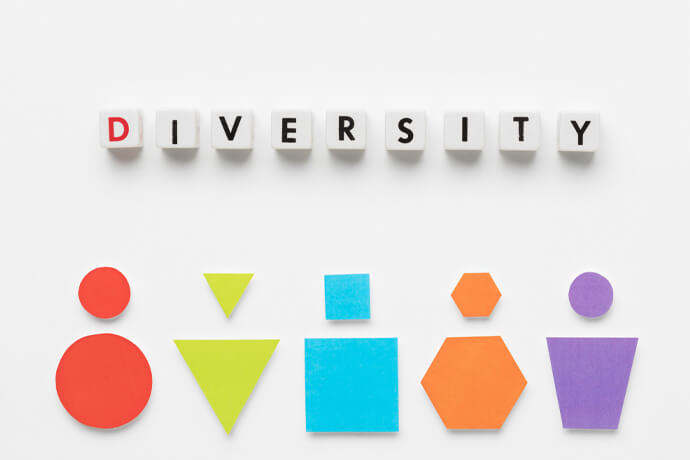 SPEAKERS
SPEAKERS
 TOPICS
TOPICS
Gain an in-depth understanding of the business case for diversity and inclusion, and barriers to their implementation. Discover strategies to create a diverse and inclusive workplace where everyone can bring their authentic selves to work.

Ensuring diversity and inclusion at the workplace facilitates a happy and productive environment for employees. Employees tend to feel safer and included in an inclusive environment, which instills a sense of belongingness in them.
As a key people management practice, diversity and inclusion delivers multiple benefits for businesses.
Top Talent Acquisition and Retention
High-performing employees are 400% more productive than employees of average performance. The extent of performance is a whopping 800% more when it comes to complex occupations such as that of software developers. Given these mind-blowing workplace productivity figures, attracting top talent is critical for any business.
With talent becoming scarcer, companies limit themselves when they restrict themselves to traditional hiring strategies. A well-developed diversity and inclusion strategy empowers organizations with an approach that attracts top talents.
Every employee, regardless of his/ her diversity, feels the need to be respected, valued, appreciated, and rewarded with fair opportunities. A diverse and inclusive workplace delivers on all these counts.
Such workplaces serve as an inspiration for top talents from diverse environments. Employees want to work and thrive in such workplaces, making these companies a popular career destination.
A diverse team brings to the table diverse life and work experiences, and unique skillsets and talents. Each of these aspects adds immense value to your workplace’s existing repertoire of talent, skills and experience.
Team abilities expand and get strengthened with diverse representation. Challenges are dissected with a unique perspective, creativity comes to the fore, and an innovative environment thrives.
Teams that discourage diversity consist of employees with similar skill sets and perspectives. Similar thought processes and approaches do not bring the best results to challenges. Results are stale, uninventive and mediocre. Innovation suffers in such environments and great moments of organizational success and growth are never witnessed.
Teams representing the neurodiverse population are capable of realizing 30% greater productivity than teams without such representation. With increased productivity and employee engagement, diverse teams are able to realize greater business performance.
Financial benefits manifest in the form of innovation profits. Research finds that venture capital (VC) collaborations are more among partners with similarities in race, gender, education or work history.
But such similar collaborations have shown only low financial performance. The more the similarities among investment partners, the lower the financial performance. Diverse collaborations, on the other hand, deliver better performance.
The difference in performance has been attributed to the inherent strength of diverse collaborations.
The research goes on to explain that projects selected by similar and diverse partners are equal in potential. However, diverse partners tend to make better decisions than their counterparts, which increases their financial performance.
The unique perspective and approach that diverse collaborations bring into decision-making are key to success. Operations, hiring, development and other critical strategies that a new venture demands for survival and growth, are well-addressed by a diverse collaboration. These are strengths that a non-diverse collaboration falls short on.

Employer branding is the reputation your company carries. Aligning goals with values, authenticity, transparency and delivering on brand promises, are key to maintaining a positive employer brand. A positive employer brand makes it easier for companies to expand their talent pool, attract top talents, and retain high-performing employees.
Diversity and inclusion are a priority factor for candidates seeking to apply for a company. A workplace without diversity is likely to discourage 41% of LGBTQ+ candidates from applying for the company.
Incorporating diversity and inclusion in your work culture and actively acting on the principle, elevates your employer brand reputation. Such workplaces are regarded as entities with social responsibility and employee-friendly.
Diversity and inclusion are legally recognized concepts in the UK. The Equality Act 2010 ensures legal protection on nine characteristics. These include age, race, religion, disability, gender, pregnancy and maternity, marriage and civil partnership and sexual orientation.
Despite the presence of legal protection, organizations have to do more to make diversity and inclusion integral to workplace culture. It is also important to be comprehensive with the characteristics included in your diversity and inclusion strategy.
With awareness increasing, modern workplaces are looking at a range of diversities in addition to those already existing and being protected. Mental health, neurodiversity, invisible disabilities, caring duties and paternity/ maternity, are some key aspects impacting the modern workplace. Your diversity and inclusion strategy must address these aspects among others for improved inclusion.
Here are some ways to ensure that your workplace is more inclusive:

Overcoming barriers to creating a diverse and inclusive workplace starts with an awareness of these challenges.
Training can increase awareness, dispel erroneous beliefs, and help counter attitudes of
unconscious bias.
Ensure that diverse teams are led by mature leaders capable of respecting and promoting
differences. Such leaders exemplify behaviours that make diverse employees feel valued and
included. Trust can be revived and maintained only with such leadership.
Conversations on the best practices for promoting diverse and inclusive workplaces are great. But strategies that back these conversations are crucial for success. Here are some strategies that enable successful implementation of best practices:
Put a strong workplace policy in place
Having a policy in place communicates your company’s stand on diversity and inclusion. The policy must be clear in its intent and implementation. It should specify behaviours that are expected at the workplace and violations that warrant strict action. A good policy also guides employees on resources for help.
Include diversity and inclusion principles across operations
It is crucial to infuse diversity and inclusion into every aspect of your organization. Such integration is essential to communicate the importance of diversity and inclusion to all stakeholders.
Have specific instructions for different organizational aspects where diversity and inclusion make a heavier impact, including:
Make your hiring process diversity and inclusion-friendly
Hiring is a key aspect of business through which you can communicate your brand’s position on diversity and inclusion. To make diverse representation on your workforce:
Make leadership teams more accountable
Your leadership must lead by example. Enforcing increased accountability for violations is an effective step towards promoting a diverse and inclusive environment.
Encourage leadership to:
Invest in activities that improve understanding of diversity and inclusion
Celebrating diversity-based events such as ethnicity-, diaspora-, and gender-specific holidays and celebrations increases awareness regarding the diversity. Your employees will get to understand the lives and places behind the faces. This understanding can have a lasting impact on their attitudes and behaviours.
You can also invite speakers specializing in diversity and inclusion to communicate the importance of a diverse and inclusive workplace. Expert speakers bring their life experiences into their speech, making the speech humorous, lively and impactful.
Make training programs on diversity and inclusion a continuous process. Training must be a structured program designed to increase awareness about discrimination, and develop skills to counter such attitude and behaviour.
An effective training program educates participants on outdated beliefs and myths that lead to discriminatory perspectives and unconscious bias. Good training programs focus on imparting the strengths of diverse and inclusive workplaces. They empower participants with authentic knowledge, and skills, that help counter biased attitudes and behaviours.
In Conclusion
Organizations that follow diversity and inclusion in principle and practice earn customer and employee trust. These organizations succeed in carving a unique competitive advantage, positioning themselves for outstanding business and individual growth.
References